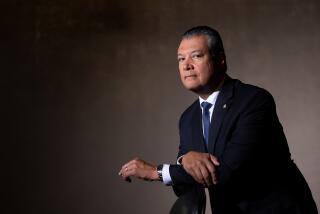Padilla case changed a lot in 5 years
- Share via
MIAMI — When federal prosecutors begin to present evidence Monday against terrorism suspect Jose Padilla, their case is expected to rest heavily on a single document: his alleged application to become an Islamic warrior.
The federal indictment says Padilla filled out the mujahedin data form on July 24, 2000, “in preparation for violent jihad training in Afghanistan.” The indictment alleges Padilla and two codefendants sought U.S. recruits and funding for foreign holy wars.
Prosecutors plan to call a covert CIA operative to testify in disguise about the document’s provenance and chain of possession, and will go on to introduce more than half of the 200-plus transcripts from wiretapped conversations among the defendants.
Nowhere in the indictment is there mention of the sensational charges leveled against Padilla when he was arrested at O’Hare International Airport in May 2002. Then-Atty. Gen. John Ashcroft said U.S. agents had thwarted a plot between Padilla, who is a U.S. citizen, and top Al Qaeda figures to detonate a radioactive “dirty bomb” or blow up apartment buildings in U.S. cities.
The case against Padilla, now 36, has come a long way since then, and illustrates how the administration’s policies of detaining suspects in the war on terrorism can backfire.
The allegations that Padilla was part of a dirty-bomb plot were dropped in November 2005, when the Pentagon transferred him out of a military brig in Charleston, S.C.
He had been held at the brig for 3 1/2 years as an “enemy combatant” with status more like the detainees at Guantanamo than a U.S. citizen incarcerated for the charges he would eventually face in federal court. Much of the time he was without human contact, daylight, any timepiece or a mirror. He was subjected to “stress positions” and extremes of heat, noise and light. And interrogations without an attorney present, the government has said, elicited information the Justice Department included in a widely publicized June 2004 report on Padilla’s alleged contacts with Al Qaeda.
The dossier on the dirty-bomb allegations was augmented by testimony that senior Al Qaeda operative Abu Zubaydah gave while in a secret CIA prison overseas, according to court papers filed in November. Zubaydah is now being held as a “high-value detainee” at the U.S. military detention center at Guantanamo Bay, Cuba.
But none of that will be admissible in his conspiracy and material-support trial. In pretrial rulings on defense claims that the government mistreated Padilla, U.S. District Judge Marcia Cooke effectively severed the conspiracy case from the dirty-bomb allegations.
She has warned prosecutors that any attempt to tie Padilla to those purported plots would mean the defense could introduce evidence on controversial and classified military detention and interrogation tactics.
The conspiracy charges came about when the Pentagon abandoned its effort to jail him indefinitely as an enemy combatant. The Supreme Court had been considering a review of his status and rights.
He was transferred to the Federal Detention Center in Miami and added to the government’s case against former school administrator and onetime San Diego resident Kifah Wael Jayyousi and computer programmer Adham Amin Hassoun.
Cooke ruled in February that Padilla was competent to stand trial, despite testimony by two mental health experts that he suffered post-traumatic stress disorder from the years in military custody.
The 44-year-old Jayyousi, a naturalized U.S. citizen of Jordanian birth, and 45-year-old Hassoun, a Lebanese-born Palestinian, had been under surveillance since the mid-1990s, the indictment says. They were arrested around the same time as Padilla.
The indictment alleges all three defendants were followers of Omar Abdel Rahman, an Egyptian Muslim cleric known as “the blind sheikh” who was given a life sentence in 1995 for inciting terrorist acts, including the 1993 bombing of the World Trade Center in New York.
According to the charge sheet, Jayyousi sought help from North American Muslim groups through his newsletter, the Islam Report, in which he called it “a religious obligation” to aid Muslims under siege in foreign conflicts. The government describes Hassoun as East Coast representative of two humanitarian aid organizations that it alleges are fronts for the support of violent jihad.
Padilla, who converted to Islam during an unrelated previous incarceration, was recruited and sent abroad to train for the defense of Muslims under siege in Chechnya, Kosovo, Bosnia, Somalia, Libya and elsewhere, the government alleges.
The indictment has few specific references to Padilla’s alleged involvement in a conspiracy. Excerpts from wiretap transcripts refer to his telling Hassoun in July 1997 that he would be ready to leave his South Florida home “soon.”
The indictment also says Padilla flew to Cairo more than a year later, and it says Hassoun and another alleged recruit spoke in September 2000 of Padilla having “entered into the area of Usama,” presumably referring to Osama bin Laden in Afghanistan.
The government alleges the defendants used code for their activities, such as “fresh air” for action in a conflict area; “tourism” for travel and upkeep expenses while abroad; and “football” for armed combat and “the other team” for foreign forces perceived as oppressing Muslims.
Jayyousi is alleged to have opened a bank account in October 1993 in the name of “Islamic Group.” According to the indictment, Hassoun managed the account over the next eight years, from which at least $40,000 allegedly went to jihad recruits’ travel and training.
Assistant U.S. Attorney Russell R. Killinger has made clear in pretrial proceedings that the government will attempt to link the Muslim aid organizations to Al Qaeda-affiliated groups, primarily through the purported jihad training application.
*
More to Read
Sign up for Essential California
The most important California stories and recommendations in your inbox every morning.
You may occasionally receive promotional content from the Los Angeles Times.











